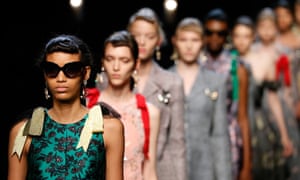
Models at the Erdem show on Monday. Photograph: Grant Pollard/Invision/AP
The make-or-break date of the autumn for Erdem Moralioğlu does not fall during fashion week. That is set for 2 November when his collaboration with H&M goes on sale. A hit on the high street will boost the profile and brand awareness of Erdem, as his label is known, more than any catwalk show ever could.
But Monday’s catwalk show was nonetheless significant for the young London-based designer. It offered a moment for the industry to assess Erdem’s form as Moralioğlu approaches the biggest hurdle of his career so far, and it was a test he passed with flying colours.
H&M collaborations are hugely popular for the opportunity they offer to buy the kind of recognisably special clothes that usually come with prohibitive price tags.
Almost every piece in this collection had wow factor in spades.

Erdem’s aesthetic is grown up and decidedly formal, which makes his high street hookup intriguing. His signature party dresses are gowns, rather than frocks. His clothes tend to have below-the-knee hemlines and, often, long slim sleeves, for an elegant line. He favours deep colours and fabrics stiffened with rich embellishment. He has a poetic, cinematic approach to fashion, fleshing every collection with a fully imagined backstory.
Having the mass consumer in his sights has not prompted Erdem to dumb down his modus operandi. This collection suggested he intends to use the H&M spotlight as Matthew Williamson, in 2009, and Isabel Marant, in 2013, did before him, to showcase an offbeat aesthetic to a wider audience.
The creation myth of this collection was a meeting between the Queen and Duke Ellington, which took place in Leeds in 1958. The encounter really happened – a photograph of the white-gloved young queen and tailcoated musician was reproduced on a board backstage at this show – and for Erdem it provided a jumping-off point for a collection that gave a late-night, jazz club twist to formal, decorous clothes.
So enamoured was Duke Ellington on meeting the Queen he announced on the spot that he intended to write a piece of music for her. “Isn’t that just a beautiful gesture? And apparently her words to him on parting were: ‘I’ll be listening,’” recounted the designer after the show. “I love the idea that they made that connection between their worlds.”

This collection showed a sexier side to the Erdem look, thanks to portrait necklines that bared models’ necks and shoulders, a contrast to the high-necked Victoriana he has become associated with. Images on the backstage moodboard drew parallels between the sweetheart necklines of couture gowns worn by the Queen in formal 50s portraits and the elegant strapless dresses worn by Billie Holiday on stage and by Dorothy Dandridge, the first black woman to be nominated for a best actress Oscar. “I started thinking, what if the Queen had gone to New York? Or, what if Dorothy Dandridge had come to Buckingham Palace? I mean, what might she have worn?” said the designer after his show.
The ballroom-sized ghost floor that languishes behind closed doors on the top floor of Selfridges was reinvented for the show as a jazz club, after hours. The catwalk meandered between salt-licked martini glasses discarded under fringed lamps, a grand piano half hidden under a dust sheet and chairs stacked in readiness for the floor sweeper. The models were dressed for their society portraits, with long gloves and heirloom jewels, ringlets ponytailed with grosgrain ribbon bows. There were grand opera coats in emerald brocade and shapely tailored pieces in heritage tweeds.
But the heart of the collection was in showstopper dresses that looked to have walked out of a Cecil Beaton photograph: shimmering pastel yellow and lush rose pinks, carefully ornamented with ribbon epaulettes and pearl edging.
[“Source-theguardian”]
